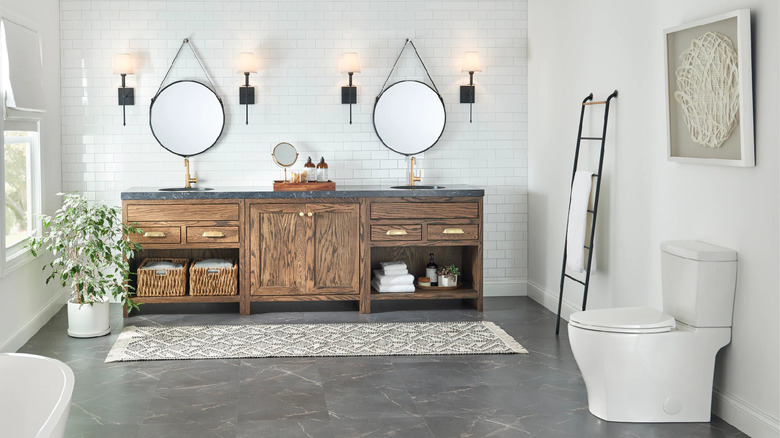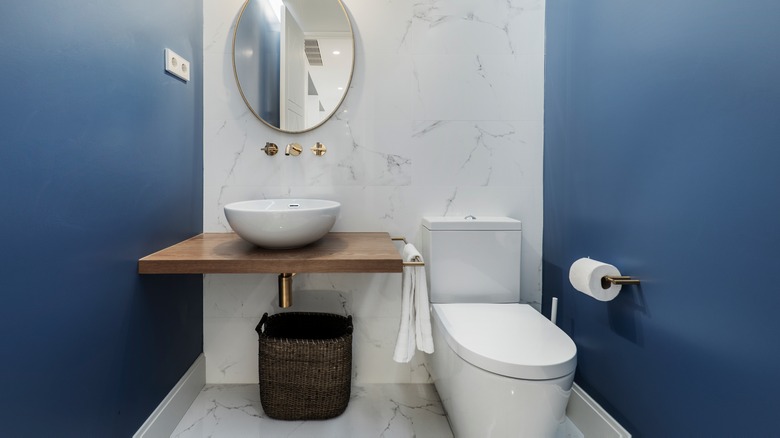What A Skirted Toilet Is And Why It Makes Cleaning Easier
Here's a safe bet for you: Most people probably already know more about the inner workings of their toilets than they want to. Unless you're diagnosing the possible location of a Cocomelon toy that was recently flushed — you probably don't need to see quite as much of a toilet's anatomy as the average model exposes. And all of the convolutions of an exposed trapway toilet have a real, meaningful downside: they're a pain to clean. This and other problems are solved by the skirted toilet, which hides all the inner workings under a smooth and easier-to-clean covering.
If you've spent any time cleaning a toilet at eye level, you know any innovation that puts you back on your feet again quicker is a welcome one — you can see why a skirted toilet is one of the most helpful toilet upgrades. Skirted toilets, sometimes erroneously described as synonymous with concealed trapway toilets, solve the problem by simply covering up all the curves that are exposed on a more basic model. The most notable of those curves are created by the trapway, the drain of a toilet that's often described as "S-shaped." Exposed trapway models were a sensible way to keep manufacturing costs down, but in recent years, the costs have equalized, so skirted toilets cost about the same as their exposed trapway cousins.
What's concealed by the skirting
All this talk of trapways oversimplifies the matter of skirted toilets a bit. In reality, it's not just the trapways that are exposed on older toilets. Skirting also sometimes hides the curvature of the toilet bowl itself and the floor flange — that horizontal shelf at the base of a porcelain toilet that the flange bolts attach to. As a result of concealing the floor flange, the flange bolts (or "Johnny bolts") are also concealed behind a little access port. Many concealed trapway toilets also obscure the water supply line and sometimes the shutoff valve located behind the toilet.
The classic skirted toilet accomplishes all this by integrating an apron that hides those parts under a smooth, easy-to-clean surface. But not all skirted toilets accomplish this to the same degree. While some completely conceal the shape of the toilet bowl, others – like Kohler's Memoirs and some of Gerber's Wicker Park models – show the bowl and hide everything below that with a smaller pedestal. Still others, like Gerber's Logan Square, reveal both the bowl and the floor flange, essentially just concealing the trapway. Since the trapway is always concealed, the supply line at the back is often partly or completely concealed as well, which can make for more difficult maintenance when you need to access it.
Cleaning the skirted toilet
So, what makes cleaning skirted toilets so much easier? The cleaning itself is obviously made simpler by the flat surfaces, which eliminate the need to scrub down into angles and crevices. Skirted models also simply shed dirt more easily, and don't tend to get as dirty in the first place. All that's normally required is a quick wipe of the apron with a cloth or sponge, using the surface cleaner of your choice. You should use a dedicated sponge or rag for the toilet, avoiding cross-contamination by taking care not to clean anything else with it. Dryer sheets are actually a great tool for cleaning your toilet, and they are disposable as well.
Skirted toilet models also tend to have simpler lines where the floor flange meets the floor, and this has another consequence for cleaning. It's easier to clean the floor around a skirted toilet. Exposed trapway toilets tend to have more intricate shapes intersecting with the floor, which creates spaces that are difficult to clean. The simplest skirted toilets, though, can usually be cleaned around easily with a quick swipe of a damp mop or brush, without the need to dig into and around tight corners and curves.


